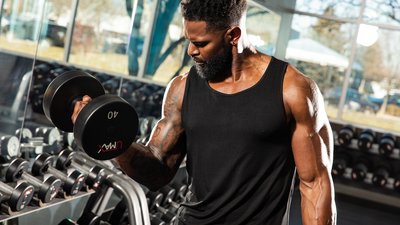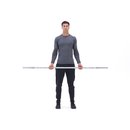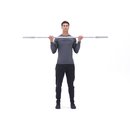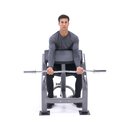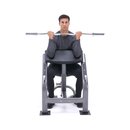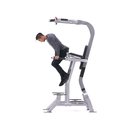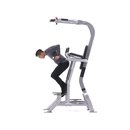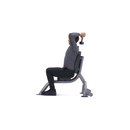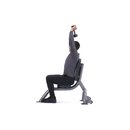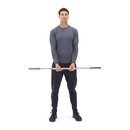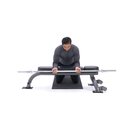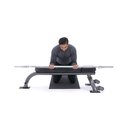If your arms have not improved over the past year, whatever you're doing in the gym is obviously not working. So-and-so many sets of barbell curls, followed by some dumbbell curls and a couple of sets of skullcrushers and tricep pressdowns - sound familiar? Well, it's time to do something drastic or you'll be stuck forever. Here are 7 steps that will give you a kick in the pants so you get back into the growth zone!
7 Steps To Kick Start Growth
1. Assessment
Bring out your training log and step back, looking at it as if you were reading someone else's. What you're looking for is stuff like favorite, ineffective exercises (identified as showing up frequently but always having the same weight and reps), stupid combinations (why first do preacher curls with a barbell and then do the exact same thing with a plate-loaded preacher machine while skipping dumbbell hammer curls?) and lack of variation from workout to workout.
Heck, pretend it's some cocky schmuck you'd like to put in his place, so be cruelly honest - the more mistakes you can dig up, the better. Every mistake you find brings you one step closer to getting some productive workouts for a change.
2. Out With The Old, In With The New
When studying the training log you probably spotted a number of exercises that show up just a little too frequently. I bet these coincide with exercises where you're either naturally strong and can use a lot of weight, or have a neat machine that you like to use. Well, not anymore. Cut them entirely for a month and only use exercises that you normally avoid.
Habit is one of the biggest enemies of progress, right up with laziness and overtraining, so smash that comfortable routine of yours with a vengeance. Hate forearm rolls, cable hammer curls and dips? Tough luck, you're doing them now! After a month or so you can bring back your old favorites, rotating them through your workout like you would any other exercise.
3. Getting The Balance Right
It's a classic mistake to focus primarily on biceps for arm growth. Sure, they look impressive once you get a nice peak worked up, but they're literally the tip of the iceberg. To get the kind of biceps you want you must train the brachialis, which is located UNDER the biceps and pushes it up. In addition, triceps make up almost two-thirds of the total arm thickness, and let's not forget the importance of the forearms to avoid "reverse-Popeye"-syndrome (beefy upper arms and twig-like forearms).
Furthermore, biceps is a relatively small muscle that grows best with a hit-hard-and-brief approach, so avoid the 16 set bicep workouts and spread the time and efforts appropriately. For example, 6 sets for biceps (making sure 2 of them hit brachialis), 8 sets for triceps and 4 sets for forearms is a reasonable split. See the sample workout for how such a setup could work.
4. Timing & Frequency
Overtraining arms is easily done. You often involve biceps and forearms during back training, with triceps getting a beating on chest day. If you're on a split that has you train through the entire body twice per week you could be hitting the same muscles almost every day, directly or indirectly. If you've read my articles in the past you know that I advocate a less-is-more approach of training each muscle group once per week as soon as you're past the beginner-stage. That should decrease the risk of overtraining considerably.
As for timing, keep your workouts short and brief: 30-45 mins is ideal, anything over 60 mins is borderline counterproductive. Last but not least, don't forget to use periodization so that you cycle between low-rep/high-rep training. Click here to read more about periodization.
5. Pump Up The Intensity
With a 30-45 min window (not counting warmup and stretching) you have to move pretty fast between exercises. You shouldn't have to walk around with a stopwatch, but aim for about a minute of rest between sets. Compound exercises like squats and deadlifts require a few minutes to catch your breath, but small muscles like those found in the arms recover relatively quickly - hit'em hard, then hit'em again to keep the intensity up.
You may also want to include some specific intensity boosters, such as forced reps, negatives, drop-sets and controlled cheating, to trigger that extra growth.
6. Checking Secondary Factors
Looking beyond the gym, try to see if you're short-changing yourself elsewhere in your life. Do you consistently get 8 or more hours per sleep per night? If not, you're robbing yourself of natural growth hormones and additional recovery. Do you eat enough calories every day?
Most bodybuilders know to eat enough protein, but that's not enough - you need a surplus of calories for the muscles to grow. If you've stayed the same weight for a while, try adding 500 calories per day and adjust as necessary. Just keep an eye on the gut - measure it with a measuring tape first thing every Monday morning.
7. Track & Reassess
The measuring tape comes in handy for tracking the progress of your arms too. Flex and measure at its thickest - repeat once a month to make sure you're making gains. If you gain a quarter-inch one month, half an inch the next, and then nothing for 4 months you know it's time to go back to Step 1 and figure out what's going on. This kind of frequent reassessment makes helps you avoid slipping back into the comfort zone.
Remember: If you're not growing at all for 3 months straight, it's time to shake things up again. Good luck!
For the low-rep/heavy-weight phase of the periodization cycle. Add 4-6 reps during the high-rep/lighter-weight phase

